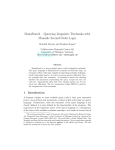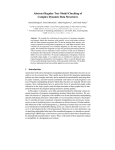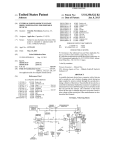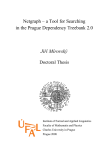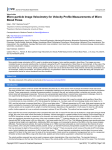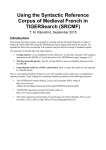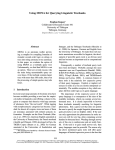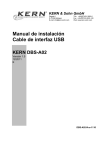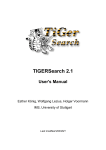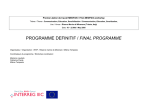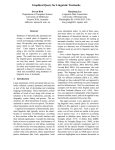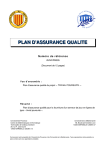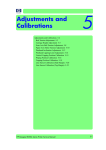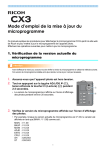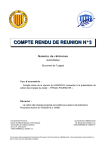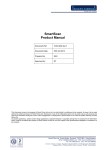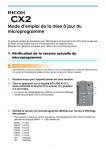Download MonaSearch – A Tool for Querying Linguistic Treebanks
Transcript
29
MonaSearch – A Tool for Querying Linguistic
Treebanks
Hendrik Maryns and Stephan Kepser∗
Collaborative Research Centre 441
University of Tübingen, Germany
{hendrik,kepser}@sfs.uni-tuebingen.de
Abstract
MonaSearch is a new powerful query tool for linguistic treebanks. The
query language of MonaSearch is monadic second-order logic, an extension
of first-order logic capable of expressing probably all linguistically interesting queries. In order to process queries efficiently, they are compiled into tree
automata. A treebank is queried by checking whether the automaton representing the query accepts the tree, for each tree. Experiments show that even
complex queries can be executed very efficiently. The tree automaton toolkit
MONA is used for the computation of the automata.
1
Introduction
A frequent critique to most available query tools is their poor expressive power:
most of them only incorporate a subset of first-order logic as a query language.
Furthermore, often the semantics of the query language is not clearly defined; it is
only defined by the functionality of the program. The importance of the expressive
power of the query language is a consequence of the sizes of the available treebanks
nowadays: tree banks of several tens of thousands of trees are no exception. It
is clearly impossible to browse these treebanks manually searching for linguistic
phenomena. But a query tool that does not permit the user to specify the sought
linguistic phenomenon quite precisely is not too helpful, either. If the user can
∗ The
work presented here is part of the project A2 in the Collaborative Research Centre 441
“Linguistic Data Structures” at the University of Tübingen, funded by a grant of the German Research Council (DFG SFB 441). We would like to thank Michael Jakl, Uwe Mönnich and Fang Wei
for interesting and fruitful discussions. We are particularly grateful to Michael for pointing us to
the function mgCheck in the MONA gta library. We also thank the anonymous reviewers for their
remarks.
30
only approximate the phenomenon he seeks, answer sets will be very big, often
containing several hundreds to thousands of trees. Weeding through answer sets
of this size is still cumbersome and not really fruitful. If the task is to gain small
answer sets, then query languages have to be powerful.
As a query language offering the necessary expressive power, we present Monadic Second-Order logic (henceforth MSO). [Kepser, 2004] describes its power
and how it can be exploited to query tree banks in linear time. This paper describes
how these ideas were successfully implemented to obtain the most powerful query
engine for treebanks to date.
MSO is an extension of first-order predicate logic by set variables. These variables can be quantified over, representing (finite) sets of nodes in a tree. MSO
offers a firm expressive power, while at the same time the automaton model discussed below assures the evaluation time of an MSO query on a tree is linear in the
size of the tree.
An example of its strength is the ability to express the transitive closure of any
binary relation which is definable in the language. Since MSO is an extension of
first-order logic, any first-order relation can be expressed in it, and thus also the
transitive closure of any first-order relation.
Transitive closures appear quite often and very naturally in linguistics. Most
often, the need for them has been met by introducing atomic formulas which directly express the transitive relation. For the ancestor relation, for example, an
atomic formula x + y is introduced, next to the more basic parent relation x y.
The limitation of this approach is that those relations are hard-coded in the logic.
There is no way to define new ones apart from extending the language. In the case
of a corpus query tool, this would mean the extra relation has to be implemented
by the programmer himself. In MSO, this can be done dynamically by the user. As
it is hard to foresee the need for such relations, this feature can come in handy.
An example illustrating this, which might be regarded as a ‘natural’ query for
MonaSearch, is the following: Consider sentences ending in a sequence of prepositional phrases like
The dog buried the bone [PP behind the tree [PP in the garden [PP in
front of the house [PP at the end of the street ]]]].
where the PPs are all embedded by one another as indicated. This contrasts with a
structure like in
The dog buried the bone [PP with his paws ] [PP under a stone ] [PP
behind the tree ] [PP in the afternoon ].
where each PP is an independent adjunct of the verb. Both examples can stepwise
be extended to sequences of PPs of arbitrary length. The query for an arbitrary
31
number of embedded PPs is not definable in first-order logic, but can be defined
in MSO. We can define the transitive closure of a PP dominating an NP as a new
relation and state that the highest PP node and the most deeply embedded NP node
stand in this new relation.
Another property of MSO which comes in nicely is its decidability over trees1 .
This assures that, when a query gives no results, this effectively means no tree in
the tree bank satisfies the formula, rather than that no tree was found.
In this paper, we present MonaSearch, a query tool which implements MSO as
a query language using automata techniques. This way we show that the theoretical
considerations are indeed also practically valid. We compare run times of a set of
linguistically motivated queries to show that MonaSearch is not only powerful, but
also faster than its main competitors.
MonaSearch is publicly available at http://tcl.sfs.uni-tuebingen.de/
MonaSearch.
2
Overview of the Querying Process
What makes MSO usable as a query language is the existence of an automaton
model for this logic. The type of automata that correspond to MSO is bottom-up
tree automata. For a general introduction to tree automata, we refer the reader
to Comon et al. [2007]. The connection between MSO and tree automata is very
strong. A set of trees is definable by an MSO formula if and only if there exists
a tree automaton accepting this set. This equivalence is constructive: there is an
algorithm that constructs an automaton from a given MSO formula.
Hence the general evaluation strategy of MonaSearch can be summarized as
follows: 1. convert the query from the user into a tree automaton, 2. run the automaton on each tree in the tree bank. In addition, some auxiliary steps are necessary
to smooth computation.
This strategy has the advantage that checking whether an automaton accepts a
tree is very fast, viz. linear in the size of the tree.
3
MONA
The largest and most demanding subpart of this process is the development of a tree
automata toolkit, a toolkit that compiles formulas into tree automata by performing
standard operations on tree automata such as union, intersection, negation, and
determinization. The most notable and successful is MONA [Klarlund and Møller,
1 More
precisely, over graphs with bounded tree width.
32
2001]. Although developed for hardware verification, MONA can be used to query
treebanks.
The language of MONA is pure monadic second-order logic of two successors.
Note that there is no way to extend this language. This has important consequences:
Firstly, we are restricted to using binary trees only; secondly, it cannot handle node
labels.
The main part of MONA is a compiler that compiles formulas in an idiosyncratic logical language into a specific variant of tree automata. The input is a file
containing the formulas. The default output is some information on whether the
formula is satisfiable or not, it is however possible to let it output a representation
of a compiled automaton into a file. Additionally, MONA offers a small library
with functions that allow one to load those precompiled automata from file and to
check if an automaton accepts a binary coded tree.
The strategy for employing MONA to query treebanks consists of two parts:
Since we don’t want to burden the user with learning the complex MONA language, a query from the user in MSO is translated into a MONA formula, and this
formula is compiled into a tree automaton by the main program. The library functions are then used to check each tree in the treebank for acceptance. The trees
from the treebank have to be transformed in a suitable way described below such
that they can be used as input to MONA’s particular type of automata.
4
MonaSearch
In this section, we’ll go into some more detail about the steps involved in a query
and the preparatory tasks, and explain how they are handled in MonaSearch.
4.1
Precompilation of the Treebank
Linguistic treebanks are usually provided in some type of data exchange format.
This format is typically unsuitable for direct querying. Plain text files are not suitable for efficient processing by their nature. Bouma and Kloosterman [2007] propose an efficient way of handling XML-encoded treebanks, but it requires the treebank to be in a specific format. E.g. the TüBa-D/Z [Telljohann et al., 2004] and
TIGER [Brants et al., 2004] treebanks cannot be queried in that way. MonaSearch
does not suffer from this restriction.
In the case of MonaSearch, there is a particular reason for a precompilation
step. As mentioned before, MONA can only cope with proper binary trees. When
translating trees from the treebank into MONA trees we consider proper trees only.
Many treebanks contain more complex structures than proper trees. At the current
33
stage of the development of MonaSearch we simplify these structures as follows:
1. secondary relations are ignored, 2. disconnected subparts are integrated into the
tree by introducing a new virtual root and connecting the disconnected parts to this
super root and 3. crossing edges are ignored by taking only the order of the children
as seen by the parent into account. In principle, these restrictions can be released:
There exists a more general method that encodes tree-like structures into proper
binary trees, as is illustrated in [Kepser, 2004].
As stated above, the precompilation of trees into formulas has to perform two
tasks: 1. the trees, which are arbitrarily branching, must be transformed into binary
trees and 2. the linguistic labels have to be taken care of.
For the transformation into binary trees, we employ the First-Child-Next-Sibling encoding, a rather standard technique. An arbitrary node x in the original tree
is transformed into x0 in the binary tree as follows:
• If x has any children, call its leftmost child y, then y0 will become the left
child of x0 .
• If x has any right siblings, call the leftmost one z, then z0 will become the
right child of x0 .
For example, the left tree in fig. 1, stemming from the TüBa-D/Z treebank, is transformed into the tree on the right. For real trees, the original tree can easily be recreated from this binary form; in fact, that is what the formula translation described
later is implicitly doing. The simplifications mentioned before, however, are not
retrievable from the binary form and are therefore not available for querying. Since
we refer to trees using an identifier, we do not need to do this back-translation explicitly, we simply use the original tree for further processing.
Note how the disconnected punctuation node at the lower right corner in the
original tree becomes the right child of the SIMPX node in the transformed tree; it
is treated as if it was its sibling in the original tree.
As can be seen in the figure, edge labels are moved down to the node below it;
thus, a node in the translated tree carries a set of labels. This is necessary either
way, since even in the original tree, the leaves carry multiple labels. We’d like to
mention that it is only a coincidence of the chosen annotation scheme and source
tree that all and only the leaf nodes of the binary tree are labelled with words. This
need not be the case in general.
Presently, labels for the category of a node, its function, the word at a leaf, its
lemma or its morphological information occur, however, other labels can be treated
the same way.
The preprocessing of the labels is still not enough to enable MONA to handle
the binary trees. The trees it expects contain bit vectors as labels, which are closely
34
(virtual root)
SIMPX
KOORD
–
$.
?
KON
–
Oder
SIMPX
VXFIN
HD
−
−
LK
ON
HD
MF
PRED
NX
ON
NE
HD
Bremerhaven
MOD
VXFIN
NX
ADVX
ADJX
HD
HD
HD
HD
Oder
ist
Bremerhaven
nicht
günstiger
?
KON
VAFIN
NE
PTKNEG
ADJD
$.
−
MF
–
VAFIN
HD
ist
−
KOORD
LK
–
ADVX
MOD
PTKNEG
HD
nicht
ADJX
PRED
ADJD
HD
günstiger
Figure 1: An example sentence from TüBa-D/Z and its binary coding.
related to the translation process. These bit vectors are, however, dependent on the
specific query and are therefore generated while querying.
4.2
Querying
The detailed steps of a query are as follows:
1. getting a query from the user;
2. translating the query into a MONA formula on binary trees;
3. compiling the MONA formula into a MONA tree automaton;
4. for each tree from the precompiled treebank:
1 preparing the tree for the query,
2 running the automaton on the translated tree, noting whether it is accepted or not;
5. presenting the results to the user.
Steps 1 and 5 are handled in a graphical user interface.
For step 2 one has to keep in mind that the user formulates his query on the
original treebank, but the trees that are used for querying are the binary coded
trees. Hence it is necessary to translate the original query φ in such a way into a
MONA formula φ 0 that the original query φ is true for an original tree t if and only
if the translated formula φ 0 is true on the binary recoding t 0 of t.
This step also has the advantage that it makes us independent of the idiosyncratic MONA language. We can offer the user an easily understandable, semantic-
35
Relation
parenthood
precedence
dominance
Formula
xy
x≺y
x + y
Translation
ex1 z: x.0 = z & right_branch(z,y)
ex1 z: ( x = z | dom(z.0,x) ) & dom(z.1,y)
ex1 z: x.0 = z & dom(z,y)
Table 1: MONA translation of the more involved base relations.
ally clear language that is almost the pure MSO logic. It also makes extending the
query language with typical linguistic relations such as c-command relatively easy.
For most connectives, the MONA counterpart can be taken over directly. This
is the case for all boolean connectives, quantification and some of the atomic relations. The main problem lies with the relations that express something about the
shape of the tree, dominance and precedence being the most relevant. Their translation uses two auxiliary predicates on the binary tree, which can be defined in the
MONA language:
• dom(x, y) expresses that x dominates y in the binary tree.
• right_branch(x, y) expresses that y lies at the branch of right children starting at x.
Note that both express the transitive closure of a first-order relation (parenthood
and right child, respectively) and as such cannot be expressed in first-order logic.
Table 1 shows the translation of the parent and precedence relations on the
original trees into a formula on binary trees in the language of MONA; see the user
manual for the notation. Note that the dominance relation could equally well be
expressed as the transitive closure of the parent relation. We include it since it turns
out that a direct translation yields a simpler formula.
Finally, all types of linguistic labels are treated as free set variables. This yields
a MONA formula φ 0 .
In step 3, the MONA formula is compiled into a tree automaton by a call to
the MONA compiler. This implies that MONA has to be installed on the system in
order for MonaSearch to work.
Step 4 comprises the actual querying of the treebank. The aim is to run the tree
automaton on each binary coded tree.
Remember that MONA is not able to handle the preprocessed trees directly.
The process of compiling a formula into an automaton translates variables into
bit vectors. More precisely the label of each node in a tree processable by the
automaton is a bit vector. The index of the vector states which variable is stored
at that place. The value (0 or 1) indicates if the node is in the set of this variable.
Since linguistic labels are treated as set variables, each binary tree must undergo
this translation process. We impose some (arbitrary, but fixed) order on the labels.
The length of the bit vector is the number of labels in the query. The index states
36
which particular label is referred to. Now consider a node in the binary tree and its
original set L of labels. The new label is a bit vector. If the index refers to a label
in L, the bit is set to 1, otherwise it is set to 0. As a consequence, the bit vectors in
the translated tree only refer to labels occurring in the query.
After this translation step the input tree is finally ready for processing. The
MONA library contains functions that load the precompiled tree automaton from
file and apply it to a translated tree returning true or false depending on whether
the tree automaton accepts the tree or not.
It remains to solve one small technicality. Remember that in the binarization
process, a virtual root node was introduced to connect disconnected parts of the
‘tree’. Care has to be taken to ignore this node when evaluating the query, in order
not to skew the results. Here, fortune has smiled upon us: the particular form
of tree automaton MONA uses happens to do just that when evaluating a simple
tree: it ignores the root node and starts looking at its left child. This left child will
necessarily be the first root node of the original tree, no further tweaking is needed.
4.3
User interface
MonaSearch offers MSO as a query language. The usual logical connectives are
provided, along with first- and second-order quantification. For the atomic formulas, those relevant for relations of nodes in a tree are chosen, along with relations
that express relations between nodes and node sets. Furthermore, (linguistic) labels
of nodes can be queried. First-order variables are supposed to range over nodes,
whereas second-order variables, the particular property of MSO, range over sets of
nodes.
The user can compose these formulas stepwise in a bottom-up fashion in the
graphical user interface, which acts like a scrap book of formulas that can be edited, connected using the logical connectives, and submitted for querying. Base
formulas can be entered from menus.
We illustrate the query language by an example of a query. In most main sentences in German – as in English – the subject precedes the inflected verb. In
yes/no-questions, this order is reversed. To find trees where the verb precedes the
subject in the TüBa-D/Z treebank, the following query may be used:
∃x, y, z(cat(x) = SIMPX ∧ cat(y) = VXFIN ∧
fct(z) = ON ∧ x + y ∧ x + z ∧ y ≺ z)
“There exist a node with category SIMPX, a node with category VXFIN and a node
with function ON; the first dominates the other two, and the second comes before
the third.” (ON codes the grammatical function subject in the TüBa-D/Z.) The tree
in fig. 1 is a sample match for this query.
37
Figure 2: The MonaSearch GUI: compose and result window
5
Performance
In order to give an impression of the performance of MonaSearch we compare
query times for a series of queries for three query tools: TIGERSearch [Lezius,
2000], fsq [Kepser, 2003], and MonaSearch. These tools were chosen because
they can be used to query any treebank and already have rather high expressiveness.
We tested their forces on the TIGER treebank and on TüBa-D/Z. The queries are
ordered by complexity starting with simple ones.
1. An NP dominating an S dominating a PP.
2. An NP dominating an S dominating a PP and an NP, which do not dominate
each other.
3. Sentences where the verb precedes the subject.
4. An NP not dominating an S which dominates a PP.
5. A PP dominating an NP which is part of a chain of embedded PPs (see
introduction).
Table 2 shows that MonaSearch performs quite well. TIGERSearch may be
faster on simple queries, but its deficit in expressive power makes it unsuitable
for querying more advanced linguistic phenomena. In fsq, such phenomena can
be queried, but MonaSearch is faster and even more powerful. Furthermore, fsq
requires a certain skill in composing a query. Processing a query with quantifier
depth 4 takes 23 seconds when the query is composed optimally. But it can also
take 46 minutes, when the query is composed in a less skilled fashion. MonaSearch
does not suffer from this problem. The processing time of logically equivalent
queries is largely independent of the particular phrasing of the queries. This makes
MonaSearch significantly easier to use.
38
Query
1
2
3
4
5
TIGERSearch
5.5
9
15
–
–
5.5
5.5
16
–
–
fsq
23
23
23
23
–
13.5
13.5
13.5
13.5
–
MonaSearch
15
15
15
15
15
10
10
10
10
10
Query times in seconds. For each query tool, the left column contains the query time on
the TIGER treebank, the right column the one on the TüBa-D/Z. A dash (–) indicates that
the query language of the tool is not powerful enough to express the query.
System: Pentium D, 3.2GHz, 1GB Ram, OS: Linux openSUSE 10.3
Table 2: Query times of MonaSearch in comparison to other tools
Since all trees are evaluated separately, the evaluation time of a query is linear
in the number of trees in the treebank. Effectively, a huge treebank with one million
trees can be queried in about five minutes, i.e., quite fast.
6
Related Work
Alternative query tools and their performance have just been discussed in the previous section. The aim of this section is to explain how the current approach differs
from the one in [Kepser, 2005]. Kepser [2005] explores a different strategy for
using MONA to query linguistic treebanks. This different strategy proved unsuccessful. The reason for this being that trees were encoded as MONA automata
featuring all linguistic labels of the treebank. As a result, the automata which encoded the trees got so big they could not be processed any more. The current
approach does not try to code trees as automata.
The current approach avoids large label sets on trees by equipping each tree
that is to be checked by an automaton with only those labels which are relevant to
the current query, as described in step 4.1 in section 4.2. By avoiding these pitfalls
the method presented in this paper is successful.
7
Conclusion and Future Work
In this paper, we presented MonaSearch, a powerful tool for querying linguistic
treebanks. The two main features of MonaSearch are the very high expressive
power of the query language and the high performance of the query engine. The
query language is monadic second-order logic. This is – to our knowledge – the
most expressive query language offered in any query tool useful for linguists. Mon-
39
aSearch is on the other hand also the fastest query system available for advanced
queries. Thanks to MonaSearch’s speed it is for the first time within reach to query
automatically annotated treebanks with several million trees with non-trivial queries.
Future work has two directions. Firstly, usability will be enhanced by simplifying the syntax of the query language, extending the range of treebank input formats
and enhancing the GUI. An important component would be a graphical treebank
browser. Secondly, it would be worth investigating whether the restriction to proper
trees can be overcome. As stated, there exists a theoretical solution for this problem. But the recoding of trees and formulas that is involved in this solution is very
complicated. Formulas may get very large. It is therefore an open question whether
these formulas can still be compiled into automata. But the potential advantage of
coping with arbitrary tree-like structures should make it worthwhile to investigate
the practicability of this solution.
References
Gosse Bouma and Geert Kloosterman. Mining syntactically annotated corpora
with xquery. In Proceedings of the Linguistic Annotation Workshop, pages 17–
24, Prague, June 2007. Association for Computational Linguistics. URL http:
//www.aclweb.org/anthology/W/W07/W07-1503.
Sabine Brants, Stefanie Dipper, Peter Eisenberg, Silvia Hansen, Esther König,
Wolfgang Lezius, Christian Rohrer, George Smith, and Hans Uszkoreit. TIGER: Linguistic interpretation of a German corpus. Research on Language and
Computation, 2(4):597–620, 2004.
Hubert Comon, Max Dauchet, Rémi Gilleron, Christof Löding, Florent Jacquemard, Denis Lugiez, Sophie Tison, and Marc Tommasi. Tree automata techniques and applications, 2007. URL http://tata.gforge.inria.fr/.
Stephan Kepser. Finite Structure Query: A tool for querying syntactically annotated corpora. In Ann Copestake and Jan Hajič, editors, Proceedings EACL 2003,
pages 179–186, 2003.
Stephan Kepser. Querying linguistic treebanks with monadic second-order logic in
linear time. Journal of Logic, Language, and Information, 13:457–470, 2004.
Stephan Kepser. Using MONA for querying linguistic treebanks. In Chris Brew,
Lee-Feng Chien, and Katrin Kirchhoff, editors, Proceedings HLT/EMNLP 2005,
pages 555–563, 2005.
40
Nils Klarlund and Anders Møller. MONA Version 1.4 User Manual. BRICS,
Department of Computer Science, University of Aarhus, January 2001. URL
http://www.brics.dk/mona/.
Wolfgang Lezius. Tigersearch – ein suchwerkzeug für baumbanken. In Stephan
Busemann, editor, Proceedings der 6. Konferenz zur Verarbeitung natürlicher
Sprache (KONVENS 2002), Saarbrücken, 2000.
Heike Telljohann, Erhard W. Hinrichs, and Sandra Kübler. The TüBa-D/Z treebank
– annotating German with a context-free backbone. In Proceedings of the Fourth
International Conference on Language Resources and Evaluation (LREC 2004),
pages 2229–2232, 2004.












